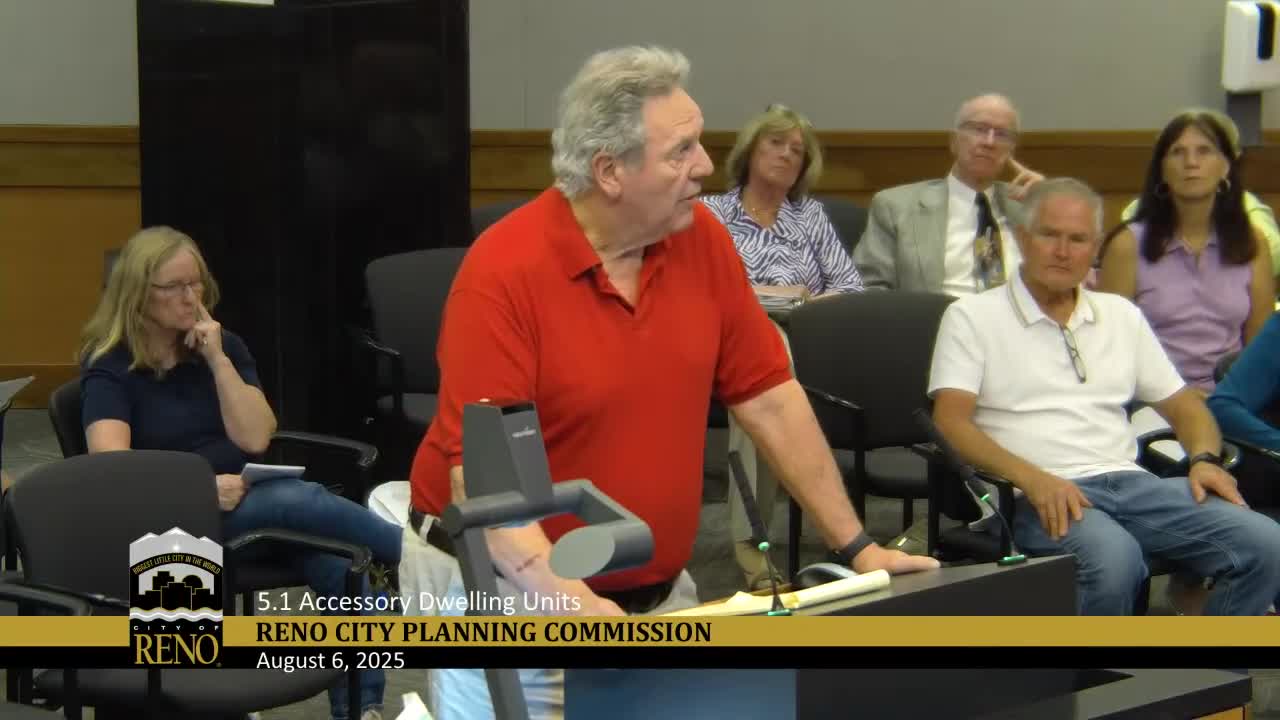Reno Council Considers New ADU Ordinance Amid Community Concerns Over CCRs
August 07, 2025 | Planning Commission , Reno, Washoe County, Nevada
This article was created by AI summarizing key points discussed. AI makes mistakes, so for full details and context, please refer to the video of the full meeting. Please report any errors so we can fix them. Report an error »

The Reno City Planning Commission meeting on August 6, 2025, focused on the ongoing discussions surrounding Accessory Dwelling Units (ADUs) and the implications of existing Covenants, Conditions, and Restrictions (CC&Rs) in the city. Key points raised by community members highlighted concerns about property taxes, zoning conflicts, and the need for clear regulations regarding ADUs.
Tom, a resident, expressed his concerns about the property tax implications for ADUs, particularly regarding vouchers that exempt certain properties from taxes. He argued that this creates an unfair burden on homeowners without such vouchers. He also emphasized the need for a thorough review of parking regulations related to ADUs.
Donna Keats, another resident, urged the commission to develop a comprehensive ADU ordinance, noting that the city is under a deadline to comply with state mandates. She pointed out that the current definitions of attached ADUs are ambiguous and could lead to conflicts with existing zoning laws, particularly concerning duplexes. Keats proposed several amendments, including establishing objective standards for size and design to ensure that attached ADUs do not resemble duplexes, which are not permitted in single-family zones.
Beth Dorey raised concerns about the impact of CC&Rs on the development of ADUs. She provided examples of neighborhoods where CC&Rs prohibit additional units, warning that ignoring these restrictions could expose the city to legal challenges. Dorey emphasized the importance of ensuring that homeowners seeking to build ADUs confirm that their properties are not subject to such restrictions.
The commission members acknowledged the public comments and discussed the need for clarity in the ADU ordinance, particularly regarding building permits and compliance with existing zoning laws. They noted that structures under 200 square feet may not require a permit but must still adhere to setback and height requirements.
As the meeting concluded, the commission recognized the importance of addressing these issues to create a balanced approach to ADU development that respects both community standards and state requirements. The next steps will involve further deliberation on the proposed ordinance and consideration of public feedback before moving forward.
Tom, a resident, expressed his concerns about the property tax implications for ADUs, particularly regarding vouchers that exempt certain properties from taxes. He argued that this creates an unfair burden on homeowners without such vouchers. He also emphasized the need for a thorough review of parking regulations related to ADUs.
Donna Keats, another resident, urged the commission to develop a comprehensive ADU ordinance, noting that the city is under a deadline to comply with state mandates. She pointed out that the current definitions of attached ADUs are ambiguous and could lead to conflicts with existing zoning laws, particularly concerning duplexes. Keats proposed several amendments, including establishing objective standards for size and design to ensure that attached ADUs do not resemble duplexes, which are not permitted in single-family zones.
Beth Dorey raised concerns about the impact of CC&Rs on the development of ADUs. She provided examples of neighborhoods where CC&Rs prohibit additional units, warning that ignoring these restrictions could expose the city to legal challenges. Dorey emphasized the importance of ensuring that homeowners seeking to build ADUs confirm that their properties are not subject to such restrictions.
The commission members acknowledged the public comments and discussed the need for clarity in the ADU ordinance, particularly regarding building permits and compliance with existing zoning laws. They noted that structures under 200 square feet may not require a permit but must still adhere to setback and height requirements.
As the meeting concluded, the commission recognized the importance of addressing these issues to create a balanced approach to ADU development that respects both community standards and state requirements. The next steps will involve further deliberation on the proposed ordinance and consideration of public feedback before moving forward.
View full meeting
This article is based on a recent meeting—watch the full video and explore the complete transcript for deeper insights into the discussion.
View full meeting